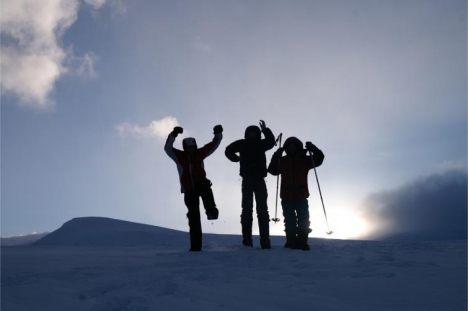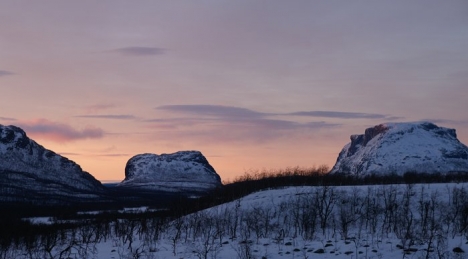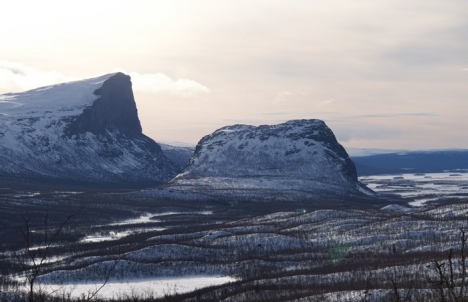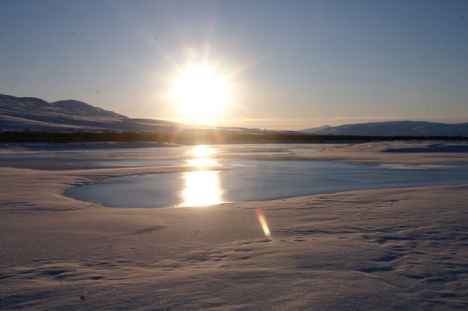In less than 10 days, this seemingly boundless 5,200 square kilometer expanse of raw nature can be crossed from west to east on skis.
But be forewarned, the harsh winter extremes aren’t afraid to put on the hurt in this great Arctic stretch of no-man's land: there are no short cuts and no huts along the way.
“To journey through the Sarek in winter is an unsurpassable experience – it is a trip of a lifetime,” says Love Rynbäck, owner of CreActive Adventure with more than 15 years of experience guiding in Lapland in Sweden's far north.
“It is a struggle between man and nature and the forces of nature quickly help you realize your own limits.”
Many consider Sarek to be the last true, continuous wilderness in the world. The immense circular park sprawls an average 50 kilometers in diameter offering limitless panoramas of unspoiled alpine massifs, narrow valleys, pristine glaciers and fast-running rivers.
“When you’re out in the Sarek, you are totally unsupported. There is nothing there. There are no shelters, no trails and only one emergency phone in the middle of the park, which of course you have to be able to get to,” says Rynbäck.
Read also: The Local's ultimate guide to travel in Sweden
He also mentions that the only man-made components of this rugged frontier are two bridges that were built solely to reduce fatalities.
Sarek is part of the World Heritage Laponian Area and is regarded as the oldest national park in Europe with its official establishment in 1909.

It is a high mountain region that lays claim to a stunning 100 glaciers and is home to six of Sweden’s 13 highest peaks towering more than 2,000 meters.
In addition Sarek is part of an area once settled by the Sámi, a group considered to be Europe’s last indigenous people who trace their polar roots back at least 2,500 years (some argue as many 8,000 years).
The guided expedition involves 9 days of unwavering commitment, strength, endurance and focus.
“This trip is an extreme challenge requiring both physical and mental strength, you don’t have to be an excellent skier but you should have a good physique and a lot of grit,” says Christian Heimroth, founder and owner of Outdoor Lapland who has offered this expedition since 2007.
At a biting latitude of 67.3º N, specific routes and total mileage can vary depending on the unpredictable, swiftly changing weather conditions. Winds reportedly have whipped up to 90-125 kilometers per hour and the wide open sky can unleash 20-40 centimeters of fresh snow in a night.
“It’s a wild feeling to be out there in the winter,” say Heimroth.
“But it’s also beautiful and often becomes a bigger experience than people expect.”

The great winter odyssey across the Sarek typically occurs in March and April, and embarks from the mountain village of Ritsem, also known as the End of the Road – literally.
Not only does the road end here, it will likely be the last human contact, aside from those in the group, throughout the remainder of the week.
“It’s real life – you bring people together who don’t know each other and we all have to work together to get from point A to point B while managing the weather, the snow, the cold,” adds Heimroth.
Pushing further into the wilds to attain complete remoteness, adventurers mount snowmobiles and barrel across Lake Akkajaure, a Sámiska term for Old Lady.
This 90-minute joyride is immediately followed by a 15-kilometer uphill ski. The night is spent in cabins at about 2,000 meters above sea level at Lake Kutjaure and marks the last night under a roof for the next week.
While covering an average 20 kilometers a day and hauling a pulka, or sledge, the journey, no matter the route, is rich in its abundance of awe-inspiring Arctic beauty, tremendous stillness and magnificent silence.
The expedition offers unmatched visas as cross-country skiers traverse the park and stand before Mikkajekna, the largest glacier in Sarek, and the Skarja massif, or “the heart of Sarek,” which sits in the middle of this vast expanse.
Skarja is also the source of Sarek’s main artery, the Rapa river, and a meeting point for several deep valleys.
“I think it’s awesome when the closest distance to any road is so very far away,” says Björn Wesley, a Gothenburg native who successfully completed the trip last April.
“Sure it’s unpleasant at times, but that’s the rules of a place like this.”
Read also: The Local's ultimate guide to travel in Sweden
Once in the Rapa valley, the journey crosses an area known as Predator Square, where moose, wolverines, lynx and arctic fox roam in the untarnished ecosystem.

Bears, also found in area, should be enjoying their annual deep sleep.
The route then continues with a 400 vertical meter gain above the treeline to the Pårte plateau and eventually ends in the mountain village of Kvikkjokk.
“The most amazing thing about this trip is you have to make it with the things you’ve brought,” adds Wesley.
“You have to make it and you will make it.”
As Wesley points out, survival on the trek is brought to its most basic level. Groups are entirely dependent on what they are collectively able to haul on their pulkas. Food becomes a source of energy, not necessarily a delectable Michelin meal.
“We try to keep the food interesting and base our offerings on local produce,” says Heimroth, the certified Laponia guide.
Dinners often range from locally smoked reindeer, to moose and even Jokkmokk sausage, not to mention fresh lingonberry jam.
Though no specific skills are required, it is suggested to be a “good” cross-country skier with prior winter camping experience and endurance training.
For the brave who embark on this challenge without savvy outdoor skills, the guides will give lessons on how to pitch a tent, pull a pulka, prevent boots from freezing, or dig-in for the night.
Although not a dangerous undertaking, guides carry all the latest technological equipment including a GPS and satellite phone in the event of an emergency.
“The biggest hazards are blisters – even the tiniest of blisters can be hugely damaging,” warns Heimroth.
Frostbite is the second, less-common threat and typically attacks the face, fingers or feet.
While out in the great back of beyond overcoming the elements and conquering the tremendous challenge of crossing the Sarek in winter, something magical happens.
“On this trip, when people are separated from their everyday, they find something in themselves that they had forgotten and they rediscover their link to nature and answer questions they didn’t know they had,” says Rynbäck.

All photos: Outdoor Lapland


 Please whitelist us to continue reading.
Please whitelist us to continue reading.
Member comments